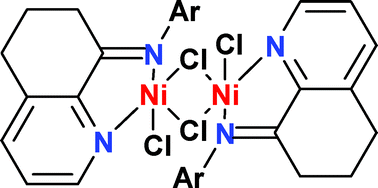Researchers at the State Key Laboratory for Oxo Synthesis and Selective Oxidation of the Lanzhou Institute of Chemical Physics have synthesized N-(5,6,7-Trihydroquinolin-8-ylidene)arylaminonickel(II) complexes。
Upon treatment with either diethylaluminium chloride (Et2AlCl) or methylaluminoxane (MAO), the nickel pro-catalysts worked as single-site catalysts for ethylene polymerization, forming polyethylene waxes with an activity of up to 107 g(PE) mol(Ni)-1h-1. The molecular weights and distributions of the polyethylene waxes could be controlled by modifying the nature of the different ligands and reaction conditions. The resultant polyethylenes were shown to be highly branched polymers; the b-hydrogen migration happened on the active species and, moreover, chain transfers from nickel species to aluminium could also take place.
The discovery of diiminonickel dichlorides as highly active procatalysts in ethylene polymerization resurrected nickel research in ethylene reactivity. There is industrial demand for both olefins, which can be produced by ethylene oligomerization, and polyethylenes, which can be produced by ethylene polymerization. However the catalytic systems used to produce both olefins and polyethylenes would be useless in this context due to the fact that polyethylenes are produced as the by-product of ethylene oligomerization and olefins are produced as the by-product of ethylene polymerization. In fact, some amount of oligomers have been commonly observed during ethylene polymerization using nickel pro-catalysts, and ethylene oligomerization is often reported due to b-hydrogen elimination in nickel-induced ethylene reactivity. Driven by academic and commercial considerations, different models of nickel pro-catalysts have been verified using ligands.
Inspired by cationic olefin polymerization employing active 14e-species, the nickel pro-catalysts bearing N,N-bidentate ligands including 2-iminopyridines have drawn more attention. However, it would be critical that nickel pro-catalysts should have single-site active species in order to produce polymers with a narrow molecular weight dispersion.
The work has received support from the National High-tech R&D Program of China (863 Program0. The findings have been published in Dalton Trans. (Dalton Trans., 2011, 40, 8436–8443).
Dalton Trans.Paper

